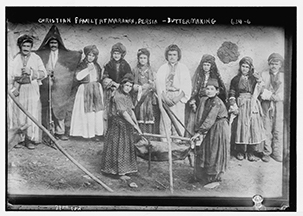12.08.2023

It was not just the Armenians that became victims of the genocidal policy implemented by the Ottoman Empire during the First World War; the other Christian minorities within the empire, Greeks and Assyrians, as well as Yezidis, were too.
August 7 was chosen as Memorial Day for the victims of the Assyrian Genocide, being officially announced as Assyrian Martyrs' Day in 1970
[1]. A great massacre of Assyrians took place in the Kurdish village of Simel in northern Iraq, which had been resettled by refugees in 1915, on that very day in 1933
[2].
According to some researchers, 3,000 Assyrians were burned alive in two Christian churches in just one day. Around 100 Assyrian villages in the surrounding area were also destroyed and looted and 6,000 Assyrian men, women and children were killed
[3]. Tens of thousands of Assyrians were displaced by force.
The Assyrian genocide of 1914-1923 and the anniversary of the Simel massacres are commemorated together. According to various estimates the massacres and deportations of Assyrians, which mostly took place during June to October 1915, took the lives of between 500,000–750,000 people.
The lawyer Raphael Lemkin, author of the term “Genocide”, also referred, in the context of the persecution of Christians in the Ottoman Empire, to the genocidal policy carried out against the Assyrians. In his book-sized manuscript concerning the massacres of Armenians, he cited, in particular, testimonies culled from the Assyrian cleric Joseph Nayem’s book “Shall This Nation Die?”
[4]about the genocide committed by the Turks against the Assyrians, Armenians and Greeks in mid-1915. Lemkin, however, gave more attention to the massacre of Assyrians by Arabs and Kurds in the Iraqi village of Simel
[5].
It is no coincidence that the first chapter of the third volume of the lawyer’s unfinished work “The History of Genocide,” titled “The Assyrians in Iraq,” was dedicated to the genocide of the Assyrians in Iraq
[6].
Lemkin wrote, in an unpublished article titled “Stop Genocide Now,” “Before the end of the First World War, about one million Armenians were killed as a result of deliberate policies. A similar fate befell the Christian Assyrians in Iraq. This is genocide. History is full of cases of genocide,”
[7].
Lemkin, during the 5th international conference dedicated to criminal law issues convened in Madrid in 1933, took the massacre of the Assyrians in Iraq and the Armenian Genocide into account in the preparation of his report and presenting his proposals on the crimes of “barbarism” and “vandalism”
[8]. He later created the concept of “the crime of genocide” on the basis of his Madrid report.
Narek Poghosyan, Ph.D.
AGMI Researcher in the Vahagn Dadryan Department of Comparative Genocide Studies
Footnotes:
[1] “Joint NGO Statement to Commemorate Assyrian Genocide Remembrance Day,” https://www.assyrianpolicy.org/post/joint-ngo-statement-to-commemorate-assyrian-genocide-remembrance-day
[2] Marlo Safi, “The Simele Massacre & the Unsung Hero of the Genocide Convention,” National Review, July 27, 2018, https://www.nationalreview.com/2018/07/simele-massacre-1933-assyrian-victims-still-seek-justice/
[3] Alda Benjamen, Assyrians in Modern Iraq: Negotiating Political and Cultural Space (Cambridge: Cambridge University Press, 2022), 17.
[4] Joseph Naayem, Shall This Nation Die? (New York: Chaldean rescue, 1921).
[5] AJHS, Raphael Lemkin Collection, P-154, Box 9, folder 2, Armenians and Assyrians, undated.
[6] Steven L. Jacobs, “Definitions and Concepts of Genocide: Lemkin and the Concept of Genocide,” in Multidisciplinary Perspectives on Genocide and Memory, eds. Armen T. Marsoobian, Jutta Linder, (New Haven, CT.: Springer, 2018), 15.
[7] AJHS, Raphael Lemkin Collection, P-154, Box 7, folder 3, Stop Genocide Now, undated.
[8] Sargon Donabed, Reforging a Forgotten History: Iraq and the Assyrians in the 20th Century (Edinburgh, Edinburgh University Press, 2015), 110․





